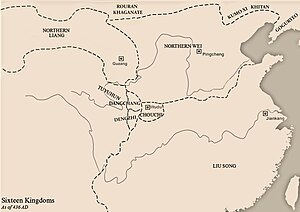Northern Liang (北涼) 建康 (397–399), 涼 (399–401, 431–433), 張掖 (401–412), 河西 (412–431, 433–441, 442–460), 酒泉 (441–442) | |||||||||||||||
|---|---|---|---|---|---|---|---|---|---|---|---|---|---|---|---|
| |||||||||||||||
Northern Liang and other Asian polities in 400 AD | |||||||||||||||
 Northern Liang at its greatest extent in 436 AD | |||||||||||||||
| Status | Vassal of Later Qin, Eastern Jin, Northern Wei, Liu Song | ||||||||||||||
| Capital | Jiankang (397–398) Zhangye (398–412) Guzang (412–439) Jiuquan (440–441) Dunhuang (441–442) | ||||||||||||||
| Capital-in-exile | Shanshan (442) Gaochang (442–460) | ||||||||||||||
| Government | Monarchy | ||||||||||||||
| Prince | |||||||||||||||
• 397–401 | Duan Ye | ||||||||||||||
• 401–433 | Juqu Mengxun | ||||||||||||||
• 433–439 | Juqu Mujian | ||||||||||||||
• 442–444 | Juqu Wuhui | ||||||||||||||
• 444–460 | Juqu Anzhou | ||||||||||||||
| |||||||||||||||
| Today part of | China Mongolia | ||||||||||||||
The Northern Liang (Chinese: 北涼; pinyin: Běi Liáng; 397–439)[3] was a dynastic state of China and one of the Sixteen Kingdoms in Chinese history. It was ruled by the Juqu (沮渠) family of Lushuihu ethnicity,[3] though they are sometimes categorized as Xiongnu in some historiographies.[4] Although Duan Ye of Han ethnicity was initially enthroned as the Northern Liang ruler with support from the Juqu clan, Duan was subsequently overthrown in 401 and Juqu Mengxun was proclaimed monarch.
All rulers of the Northern Liang proclaimed themselves "wang" (translatable as either "prince" or "king"). It was also only known as "Liang" (涼) from 399 to 401 and from 431 to 433, as their rulers took on several lesser titles while they were acting as vassals. To distinguish with the other Liang states, they were given the prefix of "Northern" by historiographers as they controlled northern Gansu when they first established. They later went on to rule the entirety of the Hexi Corridor with the key city of Guzang (姑臧, in modern Wuwei, Gansu) as their capital.
After Northern Liang fell, remnants of the Juqu clan fled and occupied the oasis city of Gaochang in 442, where they restored their state as the "Northern Liang of Gaochang" (Chinese: 高昌北涼; pinyin: Gāochāng Běi Liáng; 442–460).
- ^ "中央研究院網站".
- ^ Zizhi Tongjian, vol. 123.
- ^ a b Dien, Albert E.; Knapp, Keith N., eds. (2019-11-07). The Cambridge History of China. Vol. 2 (1 ed.). Cambridge University Press (published October 2019). p. 122. doi:10.1017/9781139107334. ISBN 978-1-139-10733-4.
- ^ Xiong, Victor (2017). Historical Dictionary of Medieval China. Rowman & Littlefield. p. 315. ISBN 9781442276161.
